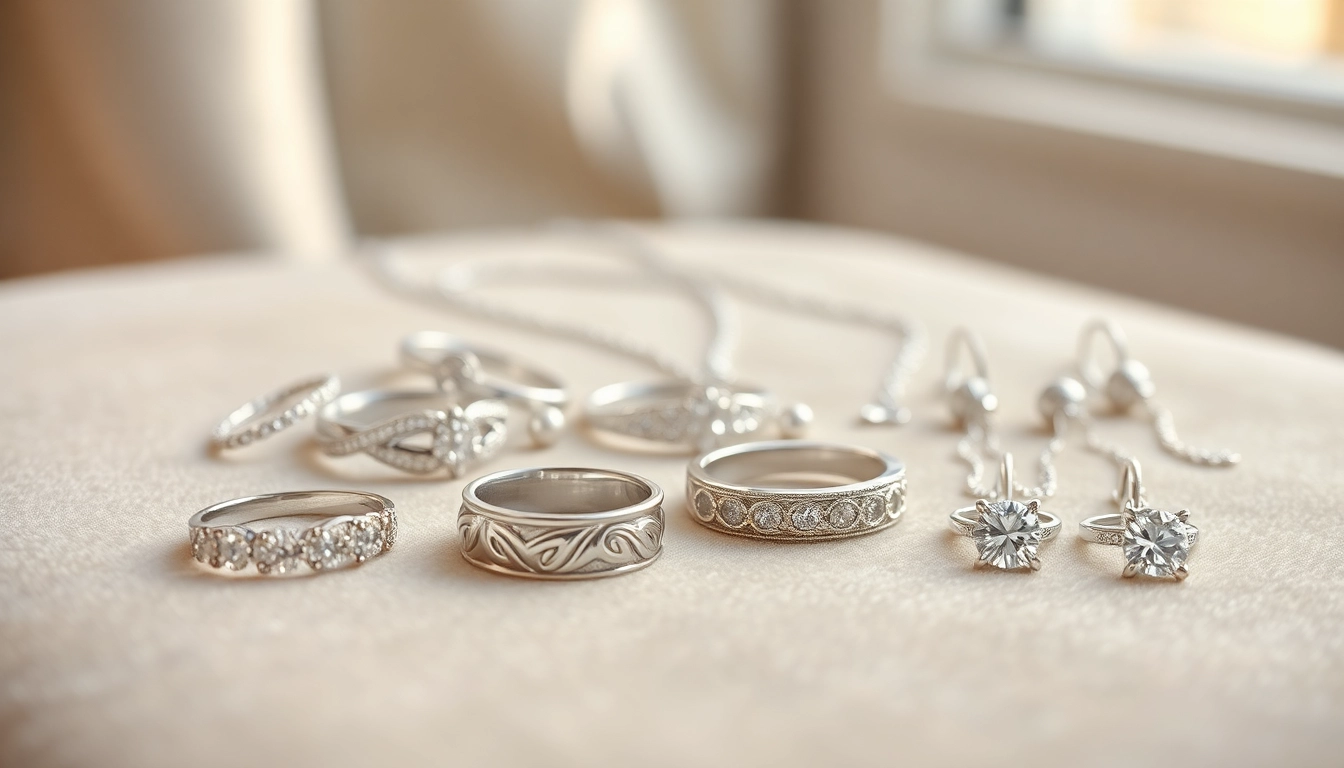Understanding Silver Jewelry
Silver jewelry has captivated humans for centuries, serving not only as a decorative accessory but also as a reflection of culture, identity, and craftsmanship. The allure of silver goes beyond its shiny surface; it encompasses a rich tapestry of history and cultural significance. Silver jewelry is both timeless and versatile, making it a beloved choice for adornment across various societies. In this comprehensive exploration, we will delve into the intricate details of silver jewelry, from its historical roots to contemporary designs, maintenance tips, and where to acquire quality pieces.
History and Cultural Significance
The use of silver in jewelry dates back to ancient civilizations. Archaeological findings suggest that silver was first mined around 3000 BC in Anatolia (modern-day Turkey) and subsequently became popular in Egypt and Mesopotamia. The metal’s luster was often associated with the moon and deities, thus holding a special place in cultural and religious practices.
Throughout history, silver has symbolized wealth and status. In ancient Rome, wearing silver often indicated social rank. Meanwhile, many indigenous cultures worldwide crafted intricate silver jewelry pieces with unique symbolism reflecting their heritage. Such pieces often featured motifs significant to their beliefs, such as animals, plants, and geometric shapes. Today, the cultural significance of silver jewelry continues, serving as a contemporary marker of identity and personal expression.
Types of Silver Used in Jewelry
When discussing silver jewelry, it’s essential to differentiate among the various types of silver used in crafting these beautiful pieces:
- Fine Silver: Comprising 99.9% pure silver, fine silver is softer and more malleable than sterling silver, making it less suitable for everyday wear. It is often used for intricate designs.
- Sterling Silver: The most popular form, sterling silver is an alloy of 92.5% silver and 7.5% other metals, typically copper. This blend increases its durability while maintaining its beautiful sheen.
- Argentium Silver: A modern alternative to traditional sterling silver, it contains 92.5% silver and includes germanium for tarnish resistance. This silver retains its luster longer than standard sterling.
- Mexican Silver: A term used for silver jewelry crafted in Mexico, often made from sterling silver but sometimes containing higher purity levels. Mexican artisans incorporate traditional techniques and unique designs.
Differences Between Sterling Silver and Other Variants
Understanding the differences between these alloys is crucial for consumers and collectors. Sterling silver’s strength makes it ideal for everyday jewelry, whereas fine silver’s softness eams it less practical for items subject to wear, such as rings. Argentium silver’s tarnish resistance is a considerable advantage, particularly for those seeking low-maintenance options.
Popular Silver Jewelry Styles
Silver jewelry has evolved into a kaleidoscope of styles, reflecting changing tastes and preferences over the years. From minimalist designs to intricate artisan pieces, there’s a silver accessory to suit every occasion and personality.
Trendy Designs of Silver Necklaces
Silver necklaces are often at the forefront of jewelry fashion. Some of the current trendy designs include:
- Layered Necklaces: This style involves wearing multiple necklaces of varying lengths and styles, creating a personalized, bohemian look.
- Pendulum Pendants: Featuring moving elements, these pendants add a dynamic aspect to necklaces, often showcasing gemstones alongside silver.
- Initial and Name Necklaces: Personalized jewelry continues to be a growing trend, with names or initials crafted in silver for a custom touch.
Unique Silver Ring Styles
The versatility of silver rings allows for endless creative expression. Some popular styles include:
- Signet Rings: Traditionally a symbol of authority, today’s signet rings often feature unique engravings and designs.
- Stackable Rings: Thin silver rings that can be worn in combination with other rings for a trendy stacked effect.
- Statement Rings: Featuring bold designs with large gemstones or unique patterns, these rings are crafted to catch the eye and spark conversation.
Innovative Uses of Silver in Earrings and Bracelets
Silver jewelry extends beyond necklaces and rings, with innovative designs found in earrings and bracelets as well. For earrings, look for styles like:
- Hoop Earrings: A timeless staple that varies in size; contemporary changes include embellishments like gemstones or charm attachments.
- Studs: Simple yet elegant, they can range from classic designs to modern interpretations featuring unique shapes.
- Drop Earrings: These earrings hang below the earlobe and can incorporate intricate designs or bold colors for a dramatic effect.
Similarly, silver bracelets have taken on unique forms such as:
- Bangles: Rigid bracelets that can be stacked for a trendy look, often engraved or adorned with stones.
- Charm Bracelets: Allowing personal expression, these bracelets hold various charms that reflect the wearer’s interests.
- Cuff Bracelets: Open-ended designs that showcase intricate metalwork or stones, making bold statements.
Caring for Your Silver Jewelry
Caring for silver jewelry is essential to maintaining its shine and durability. With proper care, silver pieces can last a lifetime and beyond.
Best Practices for Maintenance
To keep your silver jewelry looking its best, consider the following best practices:
- Avoid exposure to chemicals found in perfumes, lotions, and household cleaners, as these can tarnish silver.
- Remove jewelry before engaging in strenuous activities, such as exercising or swimming, to prevent scratches and damage.
- Store silver pieces in a cool, dry place in tarnish-resistant pouches or wrapped in anti-tarnish cloths.
How to Clean Silver Jewelry Effectively
Cleaning your silver jewelry is vital for maintaining its shine. Here are some effective methods:
- Silver Polishing Cloth: A pre-treated cloth designed specifically for silver can remove tarnish without scratching delicate pieces.
- Soap and Water: A gentle solution of dish soap and warm water can clean most silver jewelry. Use a soft toothbrush to reach intricate designs.
- Baking Soda Paste: Mixing baking soda with water creates a paste that can help remove tarnish—apply with a soft cloth or sponge and rinse well.
Storing Your Silver Pieces to Prevent Damage
Proper storage will help prevent scratches and tarnishing. Here are some practical tips:
- Keep individual pieces in soft pouches to avoid tangling and scratching.
- Avoid storing silver jewelry in humid places, as moisture can accelerate tarnishing.
- Do not store silver next to other metals, as they can cause scratching or chemical reactions.
Where to Buy Quality Silver Jewelry
The marketplace for silver jewelry is vast, with various options available for both online and in-person shopping. It’s essential to know where to look for reliable vendors.
Top Online Retailers for Reliable Purchases
Numerous online stores have gained a reputation for high-quality silver jewelry. Some popular ones include:
- Tiffany & Co.: Known for their exceptional craftsmanship and classic designs, Tiffany’s sterling silver jewelry is a staple for luxury buyers.
- Silpada: Offering a blend of style and quality, Silpada’s collection of sterling silver rings, bracelets, and necklaces often feature unique elements.
- Super Silver: This retailer claims to be the destination for all things silver, featuring a vast selection of jewelry catering to diverse styles.
Local Artisans and Craft Fairs
Supporting local artisans not only fosters community but also provides an opportunity to find unique, handcrafted silver pieces. Numerous craft fairs and local markets showcase the talents of these artisans, who often use traditional techniques and local materials.
Evaluating Quality While Shopping
When purchasing silver jewelry, it’s essential to evaluate the quality. Look for:
- Hallmarks that indicate the metal’s purity, such as “925” for sterling silver.
- Reviews or feedback from previous customers to gauge the vendor’s reliability.
- The craftsmanship involved in the jewelry, noting any signs of poor workmanship.
Investing in Silver Jewelry
Silver jewelry can be an investment, providing both aesthetic pleasure and potential financial return. Understanding market trends and pricing is crucial for savvy buyers.
Market Trends and Pricing Insights
The price of silver jewelry fluctuates based on the global market price of silver. Keeping an eye on these trends can help you make informed purchasing decisions. In recent years, silver has seen a resurgence in popularity, driven by consumer desire for sustainable and ethically sourced materials.
Understanding Value Appreciation
As with all investments, knowledge is key. When investing in silver jewelry, consider pieces that have historical significance, unique designs, or are crafted by renowned artisans. These factors can contribute to value appreciation over time.
Silver Jewelry as Gifts: What to Consider
Silver jewelry makes for thoughtful gifts during special occasions. When selecting a piece as a gift, consider:
- The recipient’s personal style and preferences—this shows thoughtfulness and consideration.
- Occasion specificity, such as birthstones or milestone markers, to imbue the jewelry with a deeper meaning.
- Personalization options that allow customization, such as engravings or unique gem selections.
In conclusion, silver jewelry is a timeless form of adornment that combines aesthetic appeal with cultural significance. Whether you are a collector, a gift-giver, or simply someone who enjoys wearing beautiful pieces, understanding silver jewelry’s rich history, care instructions, and buying options enhances the overall experience of owning these treasured items.



